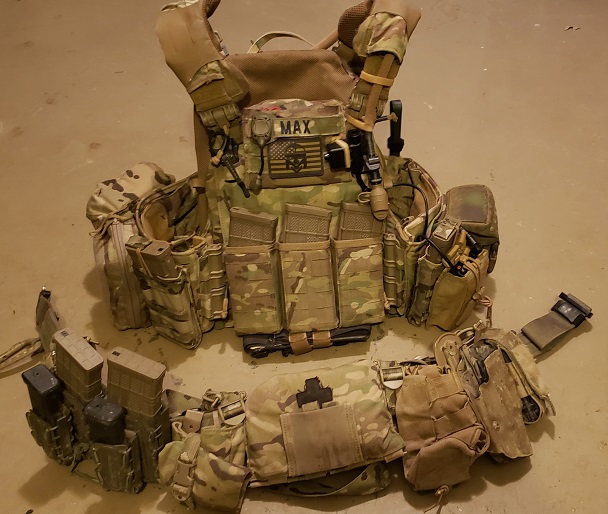
The intent of this post is to tie in the related concepts of tactical gear, fitness, teamwork, logistics and tactical loading, in order to present a realistic and logical way to approach the subject.
There are a number of related factors at play here:
Mission: We often utilize the military terminology of ‘METT-TC’ in order to analyze our mission and thus apply it to the gear that we may carry. Factors such as weather, duration and the specific mission that you are conducting all play into considerations of what to carry. We must be realistic in what we plan and train for now, and thus pack for, based around what we think we realistically might be doing in a collapse situation. I put it to you that most people will be engaged in local defense, security patrolling, and perhaps presence / ground domination activity (GDA) patrolling in and around their homestead and perhaps local community; thus not multi-day ruck-missions out into the boondocks. This has relevance as we examine the other factors.
Logistics: However much you pack, you will ultimately need a resupply. Many people with a ‘prepper’ mindset want to pack too much ‘just in case’ they need it. I would advise a different approach, one where you plan for that resupply and set up a logistics chain. If it allows you the ability to maneuver under fire, it would be better to have to temporarily make do without something, than carry a huge load. Thus you could consider something along the lines of planning to utilize vehicles such as trucks, ATV/UTV’s, and even perhaps horses or mules to support any mission that you plan that you suspect will go beyond one days rations / one first line ammunition scale (i.e. what is realistically carried on the person as part of a deployed load-out). This also ties in very well with casualty evacuation. I tell people at class that the hardest thing they will do is evacuate a casualty under fire. So much so that I propose that with today’s typical weight of person measured against poor levels of physical fitness, factoring in the exhaustion of being under fire, many casualties will not be evacuated, or at least not evacuated far. Thus, in a break contact drill, this means they will be left, or the team will be forced to strongpoint, in order to call for QRF / casualty evacuation. For this, you need communications, an actual QRF (trained and rehearsed team) and suitable transport for them to deploy to you and extract you.
Tactical Load: You should only carry what you can fight in; by which I mean maneuver under fire. Much has been said about 55lb being the maximum that a person can carry into combat, but we must remember that 1) the person must be fit and robust in the first place to manage this, and 2) this refers to weight that can be carried in on an approach march, not actually fought in. In order for the individual to be able to maneuver tactically under fire, this load must be reduced. For example, I would consider 35lb as a much more practical load weight that 55lb. This however may not include the weight of the rifle; your mileage may vary. This goes directly against carrying all that stuff that you want to carry because ‘two is one and one is none,’ and relates to the concept of logistics. An individual should not be loaded out with, for example, 16 magazines on the person, plus whatever else. They should be loaded with something more like 6-8 mags depending on the mission, with a support team moving resupply up in an ATV. “No man is an island” and you cannot fight everyone forever on your own – you can only carry a limited amount and still remain effective, and then you need resupply.
Physical Conditioning: None of these factors mean anything without the physical conditioning to carry your load and maneuver under fire. Given that many suffer from age, obesity, lack of training, injuries and medical conditions, it really does reap benefits to take a more ‘light fighter’ approach and plan to be without, rather than be with, too much. You probably do not need all those widgets and extras. There are some things that it is really sensible to carry, and that detail is beyond this article . But you cannot carry ALL that water, ammo and food, so you need to balance the needs of realistic short term missions with arranging resupply. Tied to this, is the activity of ‘rucking.’ I really do not think that anyone should be planning to do anything while carrying a ruck. Get away from the idea of ‘bug out rucks’ and all that. It is possible that you may have to carry a ruck on an approach march to set up a patrol base, but how likely is that given the missions that you may be conducting? You will also have to drop that ruck at the first contact and may likely never see it again. I posit that you are more likely to be doing relatively short term missions, if you go anywhere at all outside of an envelope of more than a mile or so from your home base. Thus, get away from heavy ‘rucking’ as training. I would advise that you train where possible with your actual tactical load-out gear, weighing around 35lb. The training value of carrying a ruck is more relevant to situations where for profile purposes, you cannot, or do not want to, go out wearing tactical gear. So then you pack a ruck to replace that for training purposes – but carry no more than 35lb in that ruck, which is a realistic combat load weight that you can use for training purposes. Alternatively, use a weighted vest, which is ergonomically similar to your plate carrier load weight.



Realistically, most of us have defined our area of operations. The above advice concerning the weight of your ruck is very sound. This should not be a concern because most of us understand the value of caches.
Every comment I have made here has been deleted.
WHY?
I thought this was a good website to share info.
Now I do not, and will limit my exposure.
Most of you won’t make it 36 hours when the SHTF.
You are dismissed,
Gunny
E-7 Ret.
78-03
Your comments have not been deleted. Not all comments are automatically approved. We get to them as fast as we can.
Wrong.
Only 2 of my few comments are posted.
Some have been actually removed.
Like the post I made on the “comms” thread about my families plan.
Good Luck guys,
I’m out of here.
Gunny
Gunny,
This comment? Do not be so quick to hit the hiway.
Good to have you here.
https://ncrenegade.com/editorial/secure-local-communications/#comments
GunnyHiWay1960 says:
January 16, 2021 at 10:58 pm
We just have a SET PLAN in my extended family here in Spokane.
If the power, cable, internet, and cell phones go out, and the new cars do not start, everyone stuffs their wheeled recycle bins and garbage cans (lined with a hefty yard bag) filled with necessities and walks to my house.
Be well,
Gunny
Why can I not post here? I am not giving out my email for security reasons.